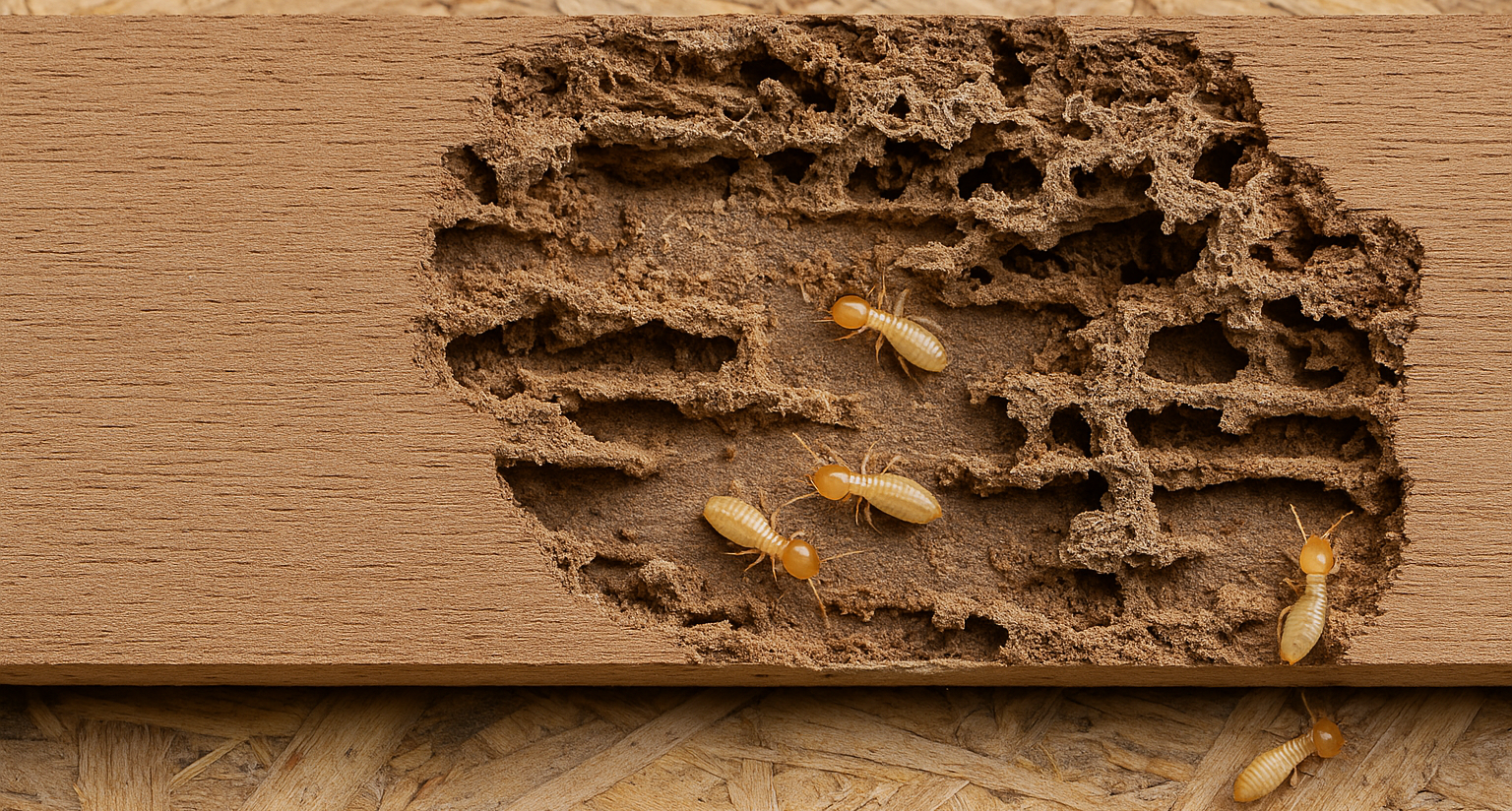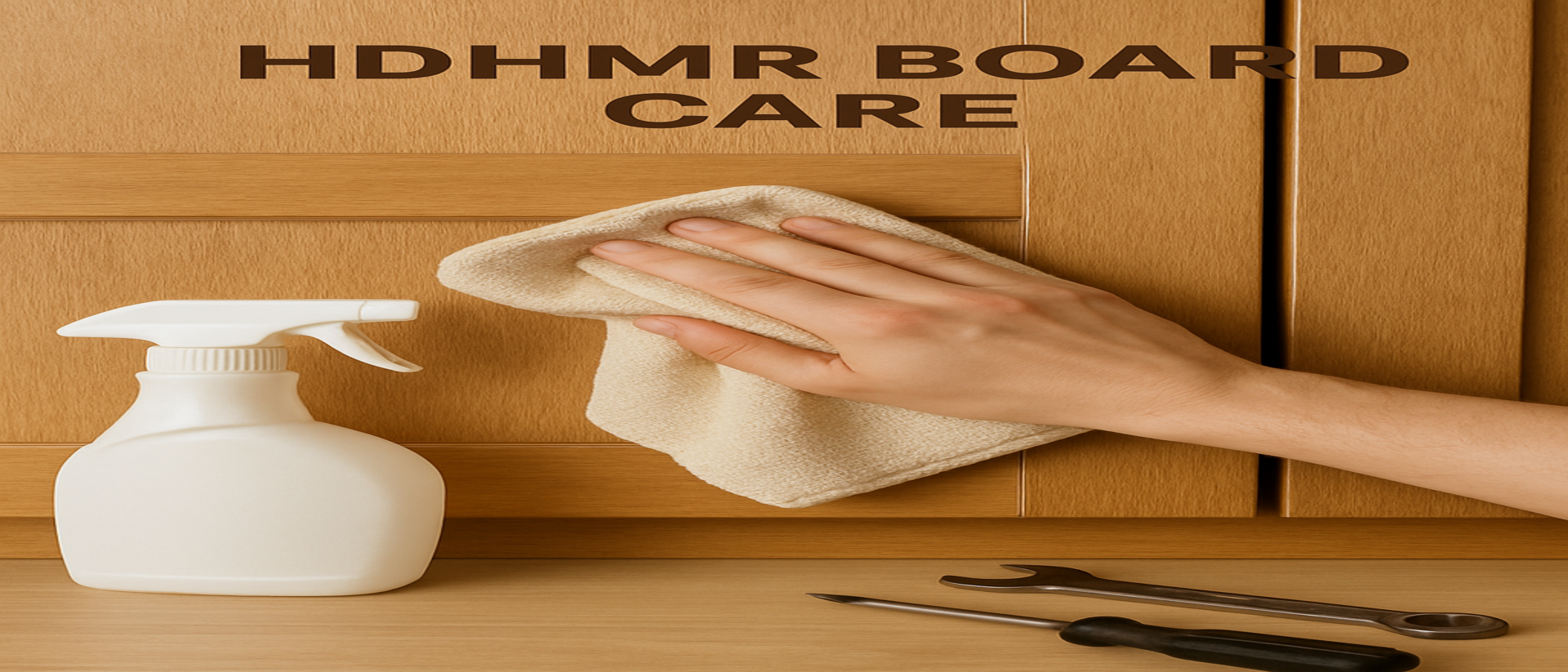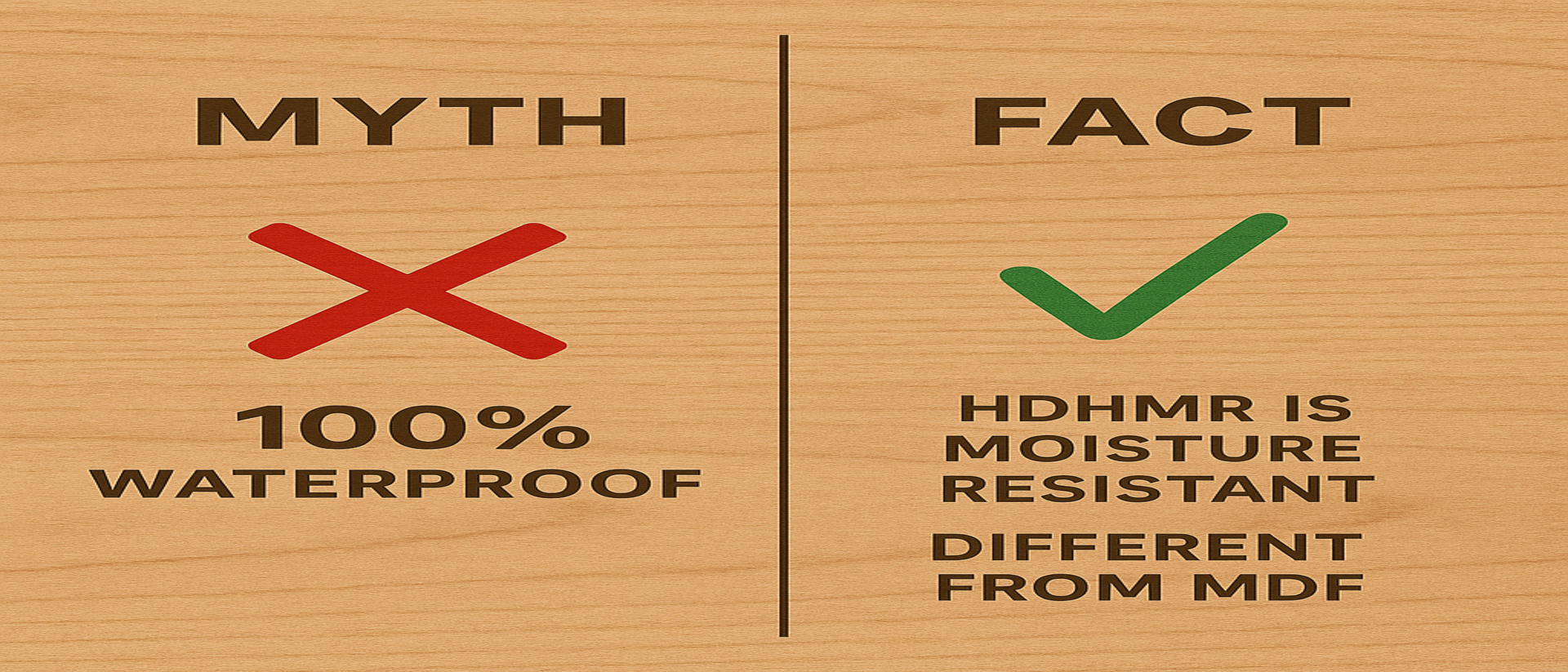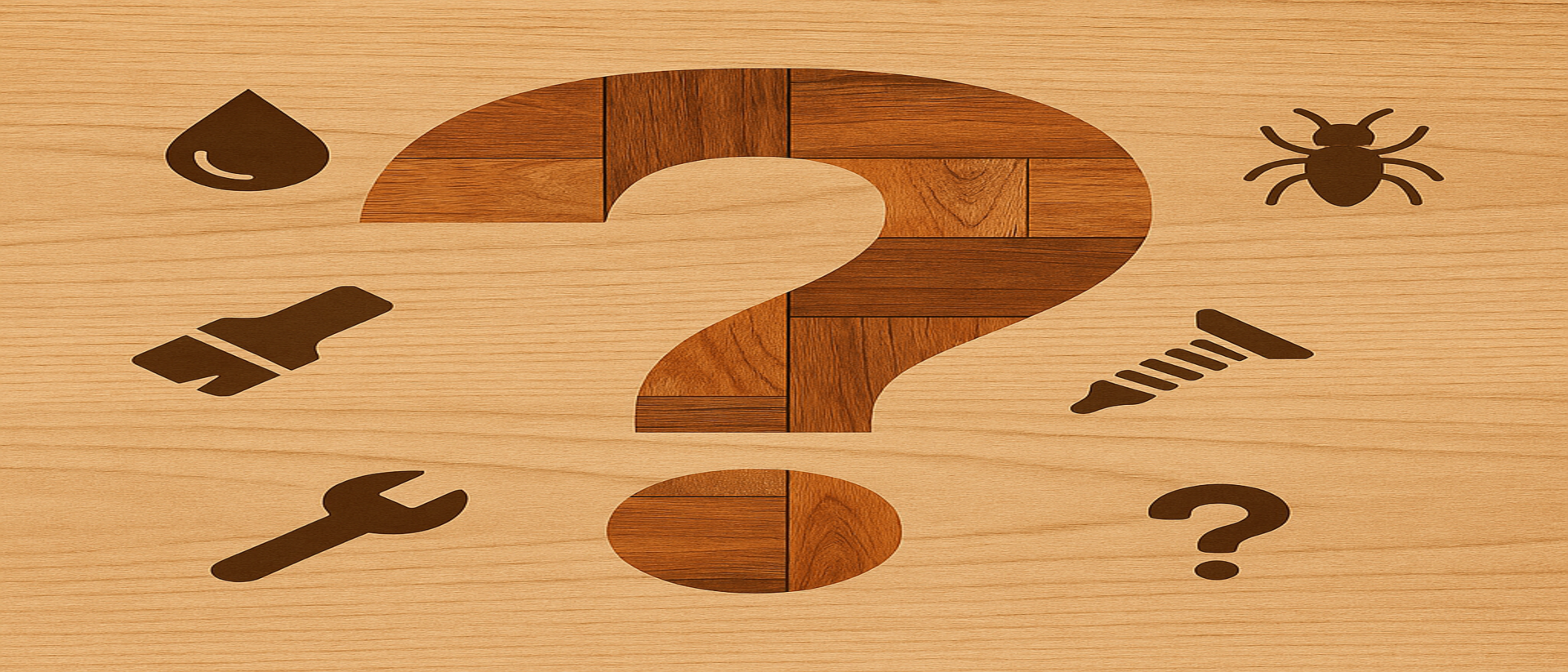When choosing a material for kitchens, bathrooms, or any interior prone to moisture and pests, questions about waterproofing, termite-proofing, and fire safety naturally arise. HDHMR board has built a reputation for being moisture and termite resistant, but as a discerning buyer, you might wonder: Is HDHMR completely waterproof? Is it truly termite-proof? And how does it behave in a fire? In this article, we’ll address these important concerns one by one, so you know exactly what to expect from HDHMR in terms of water, pests, and fire.
HDHMR and Water: Waterproof or Water-Resistant?
Short answer: HDHMR is water-resistant, not fully waterproof.
HDHMR’s “High Moisture Resistance” means it can handle humidity and the occasional splashes far better than standard wood products. The special resins used in HDHMR significantly reduce water absorption – for example, the board won’t immediately soak up a spill, nor will it warp in high humidity conditions like a regular plywood might. Users often report that HDHMR cabinets in kitchens or bathrooms remain structurally stable even after years of exposure to moisture, whereas normal MDF would have swelled and plywood might have delaminated in that timeframe. In one guide, it’s mentioned that “HDHMR ply is the best choice” for very humid locations because other wood structures tend to warp and break, but HDHMR can be used for a long time without those issues.
However, calling it “waterproof” would be an overstatement. Waterproof implies it can be submerged or exposed to water continuously without damage. HDHMR, if left in standing water or heavily soaked for extended periods, can eventually absorb water and deteriorate – it’s just much slower to do so. Think of it this way: if water is like an enemy, HDHMR has a strong defense shield, but not an impenetrable force field. The board’s surface is quite sealed (especially if laminated), so brief contact or high humidity doesn’t penetrate. But given enough time or if water manages to seep into unsealed edges, HDHMR will start to absorb it (just much less than normal wood).
For practical purposes, HDHMR handles water exposure similar to a good BWR (Boiling Water Resistant) plywood. It won’t get ruined by a few splashes or a damp environment. For instance, if you accidentally leave a wet utensil against an HDHMR cabinet side, it’s unlikely to bubble up quickly. Its surface glue line and fibers resist that moisture. But if you had a flood or a leak that kept part of the HDHMR board submerged for days, you would likely see swelling or damage. MagicBricks’ FAQ section clarifies this well: HDHMR boards “are moisture resistant but not totally waterproof. They will not warp under high humidity and incidental water exposure”. Note the phrase incidental water exposure – meaning everyday levels of moisture are fine, but not continuous waterlogging.
Bottom line: Use HDHMR confidently in kitchens, bathrooms (for vanity cabinets), and other humid spots. Just ensure you still design with common sense – seal the edges with laminate or edge banding, don’t leave raw edges exposed to standing water, and wipe up large spills in a reasonable time. If you need a material for, say, a shower cubicle constantly hit by water, you might consider plastic or PVC boards for truly waterproof requirements. But for the majority of “wet usage” in interiors, HDHMR’s water resistance is more than sufficient and a big plus over normal wood alternatives.
Is HDHMR Truly Termite-Proof?
Termites are the bane of wooden furniture, and one of HDHMR’s selling points is its termite resistance. The question is, can we consider HDHMR termite-proof in the absolute sense?
HDHMR is about as close to termite-proof as an organic board can reasonably get. Thanks to the high-density manufacturing process, HDHMR boards have a “compact core” with minimal voids or soft filler that could harbor pests. The small wood particles in HDHMR are pressed and glued so tightly that termites find it much harder to chew through compared to solid wood or plywood. Additionally, the resin itself isn’t a food source for termites – in fact, some of the chemicals are likely repellent or at least not palatable to them. Many HDHMR boards are also made from hardwood fibers and treated fibers that naturally deter termites.
In a practical scenario, people have observed that HDHMR cabinets remain termite-free even when other wood in the same house might get infested. In one example, an owner found regular plywood shelves had signs of termite attack, but their HDHMR modular kitchen units were untouched – indicating termites preferentially went for the easier meal (plywood). This is supported by the idea that HDHMR “eliminates unusable particles that can attract termites” through its pressing technique. Essentially, what attracts termites to wood is the cellulose and certain scents; HDHMR’s production cooks and presses a lot of that out.
So can we call HDHMR termite-proof? In marketing terms, yes – often it’s labeled as termite-proof. In scientific terms, it’s highly termite-resistant but one should never say never. If a colony is extremely hungry and there’s absolutely no other wood around, they might nibble at anything (even books, or in rare cases plastics). But it’s safe to say HDHMR is one of the last things termites will attack in an indoor setting. It’s worth noting that plywood, by contrast, generally is not termite-proof at all unless chemically treated – so HDHMR’s natural resistance is a huge plus. Even without periodic pest control treatments, HDHMR furniture is likely to stay safe.
For maximum security, some manufacturers produce “Green HDHMR” or add Borer Guard which basically indicates enhanced termite/borer chemical resistance (the “green” often referencing a green-colored core or eco-friendly traits, but in context of termites it implies extra treatment). If you get that variety, you’re doubling down on termite proofing.
In summary: Yes, you can consider HDHMR effectively termite-proof for everyday purposes. It’s one of the reasons carpenters say HDHMR is “safe for your kitchen cabinets” as it keeps them pest-free for years. Of course, maintaining a clean environment (no wet rotting debris around your furniture) and occasional pest inspections are always good practice, but with HDHMR you’ve got a strong inherent defense against these wood-munching invaders.
Fire Resistance of HDHMR Boards
Fire resistance is a critical safety aspect. When we ask if HDHMR is fire-resistant, we are looking at how the material behaves in presence of fire or high heat and whether it has any fire-retardant properties.
Raw HDHMR boards are not specifically fire-rated unless stated by the manufacturer. In general, HDHMR will behave somewhat similar to other wood-based materials in a fire – meaning it is combustible. However, the density and the resin content can influence its burning characteristics. Because HDHMR is very dense, it may not catch fire as quickly as low-density particle board. The resins might even char on the surface creating a sort of barrier initially. Some users have observed that when you try to ignite a piece of HDF (which is similar to HDHMR) it tends to smolder and char rather than burst into flames immediately – this is a mild fire-resistant behavior due to density. But eventually, given enough heat, HDHMR will burn.
So, HDHMR is not fireproof. If you expose it to direct flame, it will combust after some time. It’s important to clarify this because sometimes people misconstrue “moisture proof, termite proof” to extend to other things like fire – which isn’t true. Unless the HDHMR board is specially treated with fire-retardant chemicals (and a few specialized boards are, though uncommon in retail), it should be treated as a normal flammable material in terms of building codes.
That said, how does HDHMR compare to say, plywood or MDF in a fire scenario? Plywood is also combustible, but plywood might actually catch a bit faster due to layers and internal gaps allowing oxygen in. MDF and HDHMR being very compressed might burn a bit slower (like a log vs twigs). Also, HDHMR doesn’t have air pockets, so fire spread through it might be slightly impeded until the material fully heats up. Some anecdotal references mention that the charring of high-density fiberboard can delay structural failure briefly, whereas a thinner plywood might get engulfed quicker. But I would not rely on HDHMR as a fire-resistant solution by itself.
For interior applications where fire resistance is a concern (like kitchen settings), one could look at laminates or coatings that are fire-retardant applied on HDHMR. For example, if you use a fire-retardant laminate on an HDHMR substrate for your kitchen cabinets, that could give you a better fire rating. There are also Boiling Water Proof (BWP) plywoods that come with fire-retardant treatments in the market, though they are costly.
One more angle: HDHMR, being an engineered product, likely emits less smoke and toxic fumes compared to some treated plywood when burning (particularly if the plywood glue has certain chemicals). HDHMR resins are usually phenolic or melamine formaldehyde which do produce smoke but it might be somewhat less toxic than older UF glues. However, in a fire, all wood products will produce smoke and fumes – and one should always consider that in fire safety planning (like having proper ventilation and escape routes, regardless of furniture material).
To directly answer: No, HDHMR is not marketed as fire resistant in the way metal or gypsum is. If fire safety is a top priority (for example, furniture in a commercial space needing to meet fire codes), check if your HDHMR supplier has a fire-retardant grade. If not, you may need to apply external fire-retardant coatings or use alternative materials for those specific areas.
Using HDHMR Safely
Knowing these properties, here are a few tips on using HDHMR safely in context of water, pests, and fire:
- Sealing Edges: Even though HDHMR is water-resistant and termite-resistant, always seal cut or exposed edges with laminate, paint, or edge band tape. This prevents water ingress and also denies termites any exposed fiber to try nibbling on.
- Avoid Direct Water Contact: Don’t use HDHMR in direct outdoor exposure or places where it might sit in water. For instance, for bathroom flooring or exterior facades, HDHMR is not suitable. But as cupboard carcasses or wall paneling (away from direct rain), it’s fine.
- Pest Control: While you likely won’t get termites in HDHMR, keep the area clean. If you’re in a high-termite zone, it doesn’t hurt to do periodic pest control – it will protect everything else too. But your HDHMR items will likely be the last affected.
- Fire Safety Measures: Treat HDHMR furniture like any wooden furniture. Keep it away from open flames. In kitchens, have a tile back-splash behind the stove rather than HDHMR directly. Consider a flame-retardant finish if it’s a concern. And always have smoke detectors and a fire extinguisher in key areas – that matters more for safety than the choice of wood material.
In conclusion, HDHMR boards are highly moisture-resistant and can be considered termite-proof for most intents and purposes, which makes them excellent for kitchens, bathrooms, or termite-prone areas. They are not completely waterproof or fireproof, but neither are standard plywood or MDF (unless specially treated). HDHMR gives you a significant advantage in the first two aspects (water and pests) over traditional wood boards. For fire, treat it as you would any wood – with sensible precautions.
If you’re interested in more about HDHMR’s material properties, you may want to read HDHMR Composition – How It’s Made and Why It Matters, which sheds light on why it behaves the way it does. And to see how HDHMR stacks up broadly against other options, our piece on Why HDHMR is Better than MDF or Particle Board touches upon several of these points in a comparative way.
Disclaimer: This article is generated using AI-assisted research and is intended for informational purposes only. While we strive for accuracy, readers are advised to verify all technical, pricing, and brand-specific details with official sources. hdhmr.in is not liable for any decisions made based on this content.




